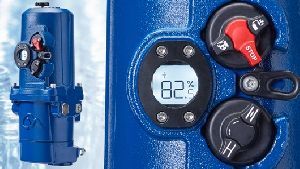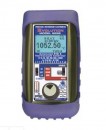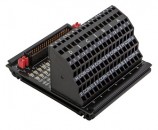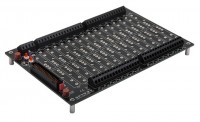 Following extensive testing, leading glass container manufacturers are specifying the Rotork CMA electric actuator for a critical valve control function in the glass making process. The valves are used to control the temperature and pressure in the furnaces by regulating the air and gas mixture with extreme precision. Maintaining a constant temperature and pressure is essential for energy efficient glass making. Traditionally, the industry uses various pneumatic and electric actuators for the modulating and isolating valves involved, but has recognised the need for a more reliable and energy efficient universal solution for this application.
Following extensive testing, leading glass container manufacturers are specifying the Rotork CMA electric actuator for a critical valve control function in the glass making process. The valves are used to control the temperature and pressure in the furnaces by regulating the air and gas mixture with extreme precision. Maintaining a constant temperature and pressure is essential for energy efficient glass making. Traditionally, the industry uses various pneumatic and electric actuators for the modulating and isolating valves involved, but has recognised the need for a more reliable and energy efficient universal solution for this application.
Tests have demonstrated that the CMA out-performs existing equipment, providing improved precision, reliability and energy savings in a compact and easy to set product that is available in a range of sizes that suits all the various valve types encountered. In addition, the CMA’s versatile ability to interface with industry-standard 4-20mA or RIRO (Remote In Remote Out) control signals enables plants in different countries to standardise on the same product.
Furnace revamps, usually taking place after a period of ten years operation, provide the opportunity to introduce the upgrade, which typically involves up to forty valves on each furnace. Following the success of the tests, several hundred ATEX certified explosion proof CMQ250 and CMQ500 actuators have been installed during revamps around the world.

 Moxa’s newly launched ThingsPro Suite is an integrated solution for distributed data acquisition and device management that can immensely simplify your Industrial IoT deployments. Built on an open Debian Linux platform, the ThingsPro Suite enables the integration of Modbus communications and device management, data acquisition and processing, and wireless networking, in a few simple steps.
Moxa’s newly launched ThingsPro Suite is an integrated solution for distributed data acquisition and device management that can immensely simplify your Industrial IoT deployments. Built on an open Debian Linux platform, the ThingsPro Suite enables the integration of Modbus communications and device management, data acquisition and processing, and wireless networking, in a few simple steps. Endress+Houser bunker fuel metering system is based upon the tried-and-tested Coriolis mass measurement, which has been used successfully in custody transfer applications in the oil and gas industry for decades. It eliminates problems with traditional measurements and ensures maximum transparency during the bunker procedure. This system, developed and patented by application specialists, ensures that air pockets are included correctly in the measurement when emptying tanks.
Endress+Houser bunker fuel metering system is based upon the tried-and-tested Coriolis mass measurement, which has been used successfully in custody transfer applications in the oil and gas industry for decades. It eliminates problems with traditional measurements and ensures maximum transparency during the bunker procedure. This system, developed and patented by application specialists, ensures that air pockets are included correctly in the measurement when emptying tanks. The PIEcal Model 525B Automated RTD & Thermocouple Calibrator is an industrial temperature sensor calibrator that accommodates RTDs (resistance temperature detectors) and thermocouples with its built-in NIST-traceable cold junction sensor. The PIE 525B is also suitable for use in calibration labs since its high accuracy and resolution are achieved by using an extremely stable, low drift circuit design featuring a +/- 0.05degC reference thermistor. In addition to registering actual temperature, the PIE 525B shows the precise resistance value when displaying RTD temperature. It features patented automatic detection of 2, 3 or 4 wire RTD connections and also detects when individual wire connections are open circuit. Inputs are protected up to ±60VDC against possible misconnection.
The PIEcal Model 525B Automated RTD & Thermocouple Calibrator is an industrial temperature sensor calibrator that accommodates RTDs (resistance temperature detectors) and thermocouples with its built-in NIST-traceable cold junction sensor. The PIE 525B is also suitable for use in calibration labs since its high accuracy and resolution are achieved by using an extremely stable, low drift circuit design featuring a +/- 0.05degC reference thermistor. In addition to registering actual temperature, the PIE 525B shows the precise resistance value when displaying RTD temperature. It features patented automatic detection of 2, 3 or 4 wire RTD connections and also detects when individual wire connections are open circuit. Inputs are protected up to ±60VDC against possible misconnection. New SNAP-UDC-HDB-G4 and SNAP-UDC-HDB breakout boards from industrial automation manufacturer Opto 22 boost the capabilities of 32-point SNAP digital I/O modules, simplify field wiring, and save panel space. With the SNAP-UDC-HDB-G4 breakout board, OEMs, machine builders, and automation professionals can connect 32-point SNAP digital I/O modules to higher loads and gain the reliability of fused outputs and isolated inputs, while the space-saving SNAP-UDC-HDB breakout board provides convenient spring-clamp connectors for up to 32 field devices, all in a small footprint. Both new breakout boards are part of Opto 22’s SNAP PAC System, which includes programmable automation controllers (PACs), Ethernet-based I/O systems, and PAC Project automation software.
New SNAP-UDC-HDB-G4 and SNAP-UDC-HDB breakout boards from industrial automation manufacturer Opto 22 boost the capabilities of 32-point SNAP digital I/O modules, simplify field wiring, and save panel space. With the SNAP-UDC-HDB-G4 breakout board, OEMs, machine builders, and automation professionals can connect 32-point SNAP digital I/O modules to higher loads and gain the reliability of fused outputs and isolated inputs, while the space-saving SNAP-UDC-HDB breakout board provides convenient spring-clamp connectors for up to 32 field devices, all in a small footprint. Both new breakout boards are part of Opto 22’s SNAP PAC System, which includes programmable automation controllers (PACs), Ethernet-based I/O systems, and PAC Project automation software.